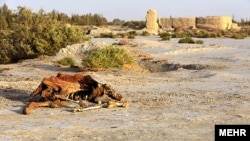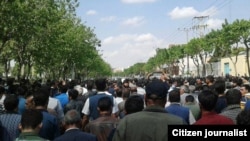Sixty wetlands in Iran, including nearly 44 percent of the country’s total marshlands, have dried up, according to the deputy head of the Department of Environment (DOE) for wetlands.
“There are some 105 wetlands in Iran, stretching 3 million hectares of land. About 1.3 million hectares of these wetlands are affected by drought, which led to total dryness of some 60 wetlands,” state-run Iran Labor News Agency (ILNA) quoted Masoud Bagherzadeh as saying on June 1.
Other wetlands are in critical condition but have not completely dried up yet, he added.
Scores of lakes, rivers, and marshlands in Iran have dried up or been exposed to drainage in the country due to either drought or water mismanagement.
As examples, Bagherzadeh cited the Jazmourian Wetland in Kerman Province, the salt marsh of Gavkhouni east of Isfahan, Lake Urmia in Western Azerbaijan Province, and Gandoman Lagoon in Chahar Mahal Bakhtiari, which have lost 100 percent, 90 percent, 70 percent, and 20 percent of their areas, respectively.
In March 2017, the head of the DOE at the time, Masoumeh Ebtekar, officially declared the death of Lake Bakhtegan in Fars Province, Jazmourian Wetland, and Gavkhouni Swamp.
Forty wetlands across Iran have lost 20 to 40 percent of their volumes of water since Hassan Rouhani started his first term of presidency in 2013, Bagherzadeh told ILNA.
Rouhani’s administration had promised to implement a plan for the revival of Iran’s wetlands, including the Hour al-Azim marshland, where 70 percent of the water has been recovered.
Rouhani and his cabinet have repeatedly accused former President Mahmud Ahmadinejad’s administration of drying up Hour al-Azim to produce more crude oil.
The Hour al-Azim or Hawizeh marshes are a complex of wetlands that straddle the Iran-Iraq border. The marshes are fed by two branches of the Tigris River, the Euphrates in Iraq, and the Karkheh River in Iran.
DOE officials have repeatedly warned that Turkey’s plan to construct the Ilisu Dam on the Tigris poses a serious environmental threat to Iraq and eventually Iran by reducing the flow of the river to Iraqi territory by 56 percent.
The director for environmental impact assessment at the DOE, Hamid Jalalvandi, says, “Once the IIisu Dam is built, Hour al-Azim Wetland, which has already been struggling with drought conditions for years, will eventually dry up, triggering a major environmental catastrophe in Iran.”
State-run Mehr news agency (MNA) also cited Jalavandi as saying, “The dam will not only pose an environmental threat to southern Iran but will also affect the northern and northwestern regions.”
The Tigris River flows south from the mountains of southeastern Turkey through Iraq. Before flowing into the Persian Gulf, it joins the Euphrates to form the Shatt-al-Arab, which along with the waters of the Karkheh River in Khuzestan Province, feeds the Hour al-Azim Wetland on the Iran-Iraq border.
The shrinkage of Hour al-Azim in recent years has intensified sandstorms that have hit Khuzestan and neighboring provinces.
One of the most important issues in wetland restoration projects is the allocation of water rights, the deputy environment chief noted. Sharing water in drought-hit Iran has become a bone of contention between residents of several neighboring provinces.
Radio Farda reported on April 13 that farmers protested in Isfahan against the mismanagement of water resources. Hundreds of farmers from eastern parts of the province stormed the provincial capital, among them many women, chanting, “America is not our enemy; our enemy is right here.”
Reports said throngs of anti-riot forces with tear-gas gear and buses equipped with water cannons faced the protesters.
In an earlier protest, the farmers swamped Friday Prayer in Isfahan on March 16 and turned their backs to the prayer leader as they chanted, “Turning away from the enemy, eying the motherland.”
Referring to these protests, Bagherzadeh noted, “A council comprising the energy minister and the governors of Isfahan, Yazd, and Chahar Mahal Bakhtiari provinces, as well as deputies of relevant departments along with the representatives of upper and lower land farmers, should address and resolve the problem of sharing water from the Zayandeh Rood River.”






